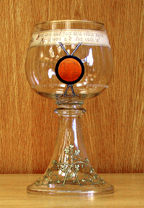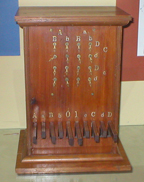|
Web Exclusives:
Under the Ivy Sept. 27, 2006:
Left: A 13-inch-tall crystal Princeton goblet from the 1870s (PAW photo). Right: Allan Marquand's "logic machine," on display in the Fine Hall Library (Courtesy Fine Hall Library) It’s always a blast to find some humanity behind the façade of legend. The idea that great accomplishments came from real people, not demigods from another world, is not only instructive but downright warm and fuzzy. Who doesn’t cling to the image of George Washington p1799’s wooden teeth? When my recent e-mail yielded a kindly note from Allan Marquand 1874’s grandson, G. Allan Forsyth ’53, it unexpectedly turned out warm and fuzzy. Marquand, the founder of the Department of Art and Archaeology and sole creator of the great Princeton Art Library, benefited the University along with his father, Henry, during the critical period when James McCosh was essentially restarting the place from scratch after the Civil War. Henry Marquand’s name was on the first presentable College gymnasium, built in 1870, and on the chapel built in 1882 that tragically burned in 1920. It lives on in the Marquand transept of the current University Chapel. Allan, meanwhile, burned up the track in many senses as an undergrad, a prize-winner on the cinders as well as a gymnast and rower. The president of the Class of 1874, he tied for first in the class academically and delivered the Latin salutatory address. Ex post Princetoniensis, he studied theology at Princeton and Union seminaries and earned a Ph.D. in philosophy at Johns Hopkins while finding time to invent a mechanical precursor to the modern computer, the “logic machine” that graces the Fine Hall Library to this day. Returning to McCosh’s faculty in logic and Latin, a year later he became the only art instructor and got his uncle to endow a professorship that he then filled (note to aspiring academicians). With the chair, the gym, and the chapel all bearing the family name, he proceeded to create the Art and Archaeology department and its renowned museum and the Allan Marquand 1874 Art Library, including many of his own personal donations. He stopped along the way to vacate the endowed chair in 1910 so that another art faculty member could be hired, then served gratis for the rest of his Princeton career. This is a gesture that has not subsequently become a big trend in local professorial circles. From his single course in 1882, by his retirement the department had 13 faculty members. So what, then, of the news in my e-mailbox from the Marquand family? It seems the thoughtful Allan ’53 had an Allan 1874 keepsake that the University might wish to have. (The faculty is agog: A priceless, long-lost Tintoretto? A hand-written senior thesis in Latin on the weaknesses in Plato’s logic?? A treatise on relativity – with working model – predating Einstein by 15 years???) Nope, a goblet. A 13-inch-high crystal goblet. Boy, the track team really knew how to train in those days. From Marquand’s undergraduate days, and graced with the college seal, it also carries a proud locomotive inscribed beneath. This was well prior to the standardization of the Princeton seal in 1896, so the motto on it, rather than “Dei sub numine viget,” reads “VITAM MORTUIS REDDO” (“I restore the dead to life”). While this is a pretty clear indicator that the goblet wasn’t used for flower arrangements, the clincher is found lovingly engraved in the banner above the seal: “How cool and fair this cellar where/ my throne a dusky cask is!” The perfect place to compose your Latin salutatory, if ever there was one. Now this is somebody you want for an art professor. If you’re going to be forced to slog through Botticelli and Rubens, do it with a locomotive and a foot-high pinot grigio. Which brings to mind the natural question: Exactly how did Marquand get along at the seminary? Forsyth provides an answer to that as well. “According to family legend, Marquand said that he gave his first sermon and then stood outside the church door after the service, hoping for praise from his flock. No one spoke to him, but he did overhear one elderly lady say to another, ‘I thought the new minister read the hymn numbers rather well, didn’t you?’ ” Of such insights are great art history legends made. Allan Marquand’s goblet now graces the Mudd Library archives at Princeton,
with many thanks to a family with a longstanding sense of humor as well as a
sense of history.
|



 Gregg Lange ’70 is a member of the Princetoniana Committee and the
Alumni Council Committee on Reunions, an Alumni Schools Committee volunteer,
and a trustee of WPRB radio. During the Reunions P-rade, he can be found at the
reviewing stand microphone, attempting to create drama from innumerable meandering
swatches of orange and black.
Gregg Lange ’70 is a member of the Princetoniana Committee and the
Alumni Council Committee on Reunions, an Alumni Schools Committee volunteer,
and a trustee of WPRB radio. During the Reunions P-rade, he can be found at the
reviewing stand microphone, attempting to create drama from innumerable meandering
swatches of orange and black.